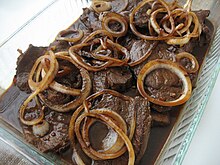Bistek
 Bistek Tagalog from the Philippines | |
| Alternative names | Bistec encebollado (Spanish), bistek Tagalog (Filipino) |
|---|---|
| Course | Main course |
| Place of origin | Spain |
| Serving temperature | Hot |
| Main ingredients | Beef sirloin or tenderloin, salt and pepper. Regional variations may include onions, garlic, oregano, cumin, calamansi juice, soy sauce |
| Other information | Eaten with rice |
| Part of a series on |
| Steak |
|---|
Bistek (Spanish: bistec) or bistec is a Spanish loan word derived from the English words "beef steak" abbreviated.
Variations[]
The Americas[]
Bistec encebollado is a Spanish dish that can be found in all former Spanish colonies, including the Caribbean islands of Cuba, Dominican Republic, and Puerto Rico.
Regional variations include: bistec de palomilla in Cuba, bistec ranchero in Mexico, bistec a caballo (topped with hogao and a fried egg) in Colombia, and bistec a lo pobre (served with fried plantain, fried eggs, fries, and rice) in Chile and Peru.
Philippines[]
The Filipino version is called bistek Tagalog, a dish made of strips of salted and peppered sirloin beef, usually flattened with a meat tenderizing tool, slowly cooked in soy sauce, calamansi juice, garlic and onions, a specialty of the Tagalog region.[1] The onions are usually cut into rings, and are added raw when the dish is either already cooked, or almost cooked for the onions to soften but maintain its crunchiness. Bistek Tagalog is known in the Spanish-speaking world as bistec encebollado or bistec tagalo. It is usually anglicized in Philippine English as "beefsteak".
A variation of bistek in the Philippines is bistek na baboy ("pork bistek") or "porksteak", in which pork—pork chops or pork belly slices—is used instead of beef.
See also[]
- List of Mexican dishes
- List of Philippine dishes
References[]
- ^ Filipino Fried Steak - Bistek Tagalog Recipe Archived April 12, 2014, at the Wayback Machine
External links[]
- Filipino Beef Steak Recipe - Filipino Beef Steak cooking instructions.
- Food of the Philippines: Bistek Tagalog
- Bistek Tagalog (Filipino Beef Steak) - Procedures on how to cook bistek tagalog.
- Beef dishes
- Mexican cuisine
- Philippine cuisine
- Tagalog words and phrases
- Meat stubs
- Mexican cuisine stubs
- Filipino cuisine stubs










